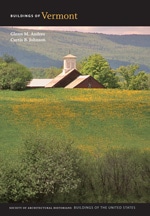This Greek Revival replacement for Lunenburg's first Congregational Church, lost by fire in 1849, is so close in design to St. Johnsbury's South Congregational Church (CA12) that it almost certainly shares the same model, the demolished St. Johnsbury North Congregational Church, and possibly the same builder. The similarities are numerous: the clapboarded body and matchboarded facade, projecting entrance pavilion, narrow paired corner and single broad central pilasters, pedimented gable parapet, and tower sequence of square base, open belfry with square posts and inset balustrade, square-windowed lantern, and octagonal spire. The differences—the two entrance doors that flank a central window and the octagonal rather than a circular belfry—are indicative of a more modest scale and budget than those of its St. Johnsbury model. The major impact of the reduced scale, however, is in the sense of the proportional relationship among the parts. The entablature is heavier and the texture of the architrave and stepped transitions in the tower more insistent, giving this fine little building a distinctive vigor quite apart from its refined St. Johnsbury precedent.
The steeple was painstakingly restored by volunteers in 2007–2009, and community efforts to restore the church have been ongoing.
References
"Our Progress." The Top of the Common Committee. https://www.topofthecommon.org/our-progress.





















